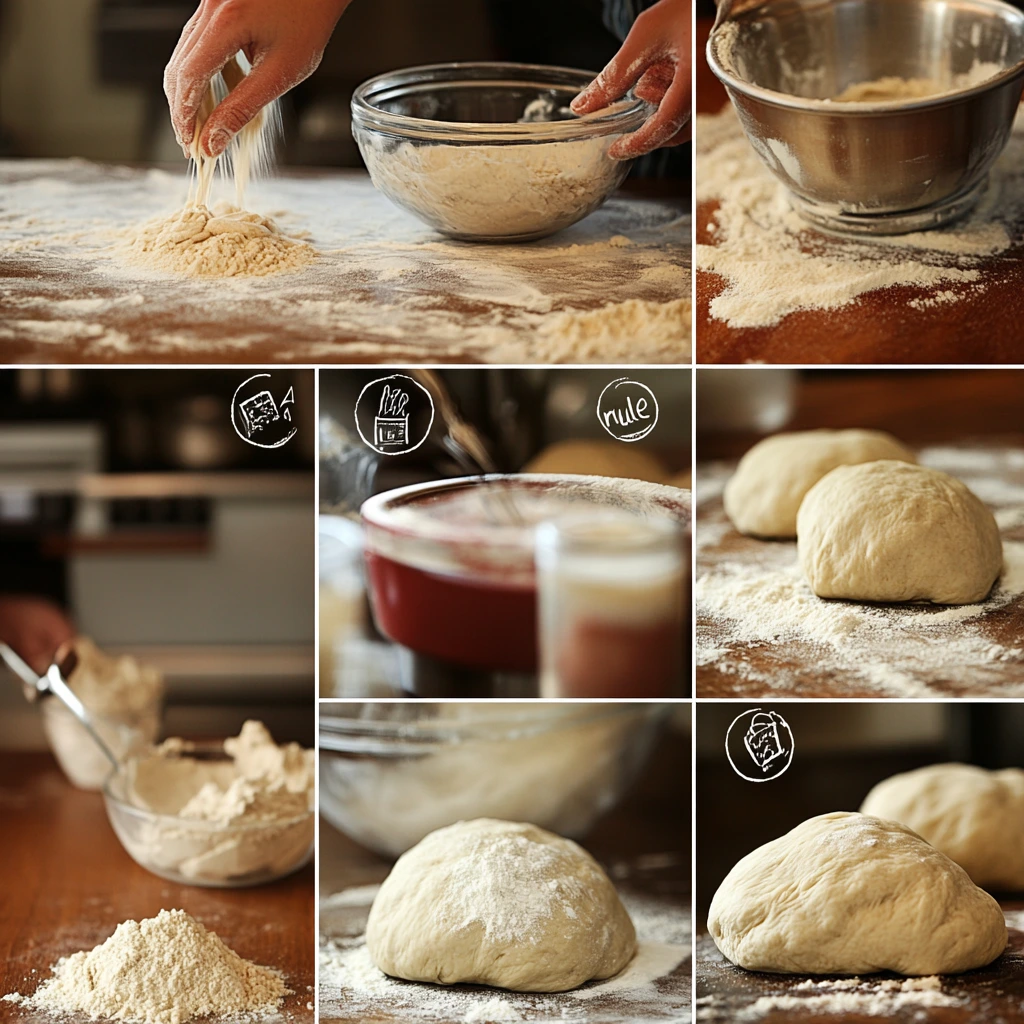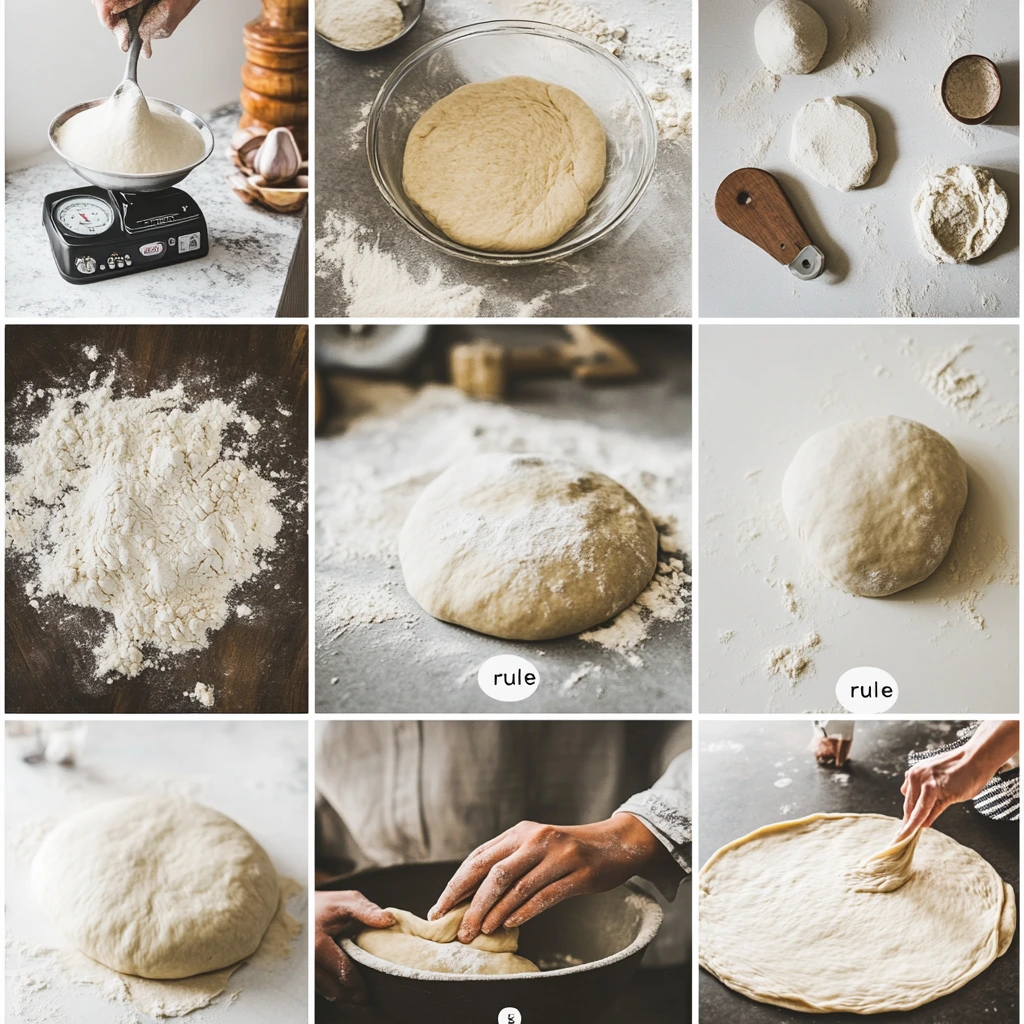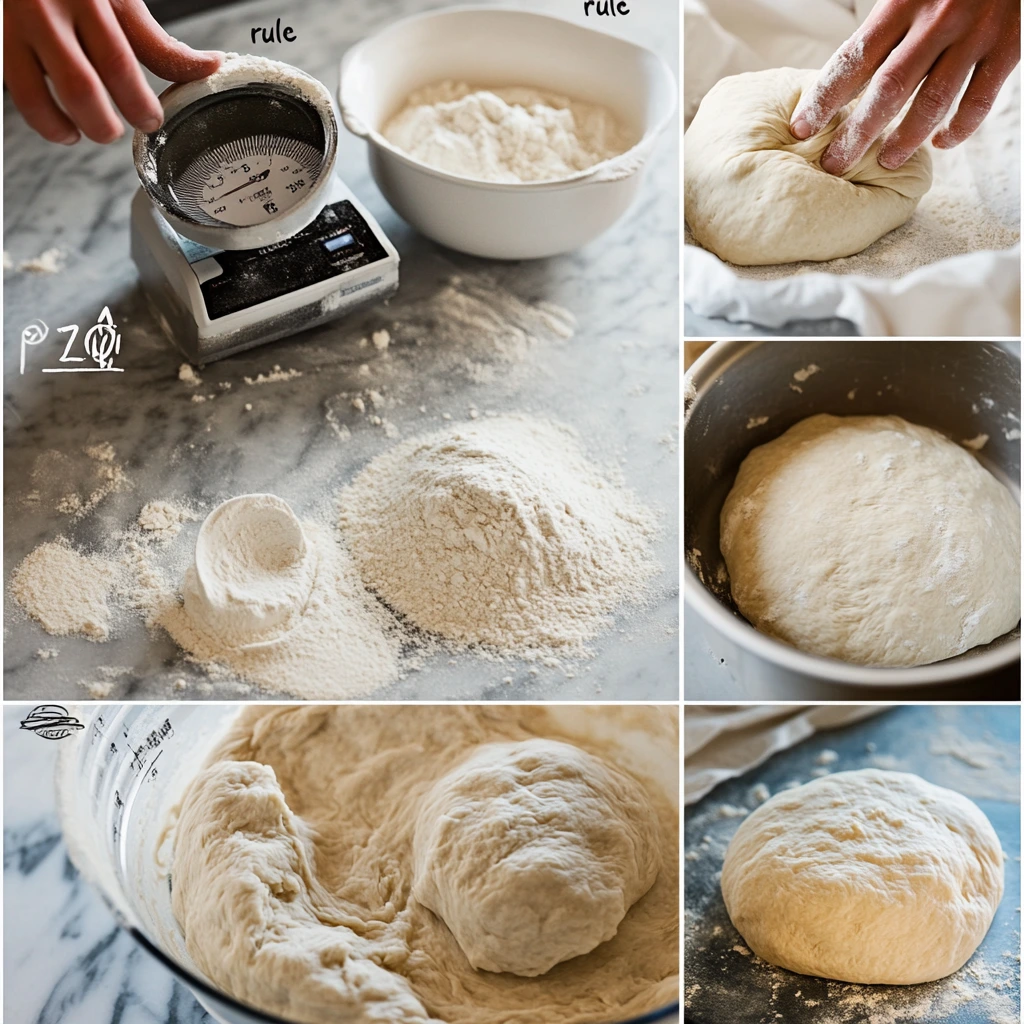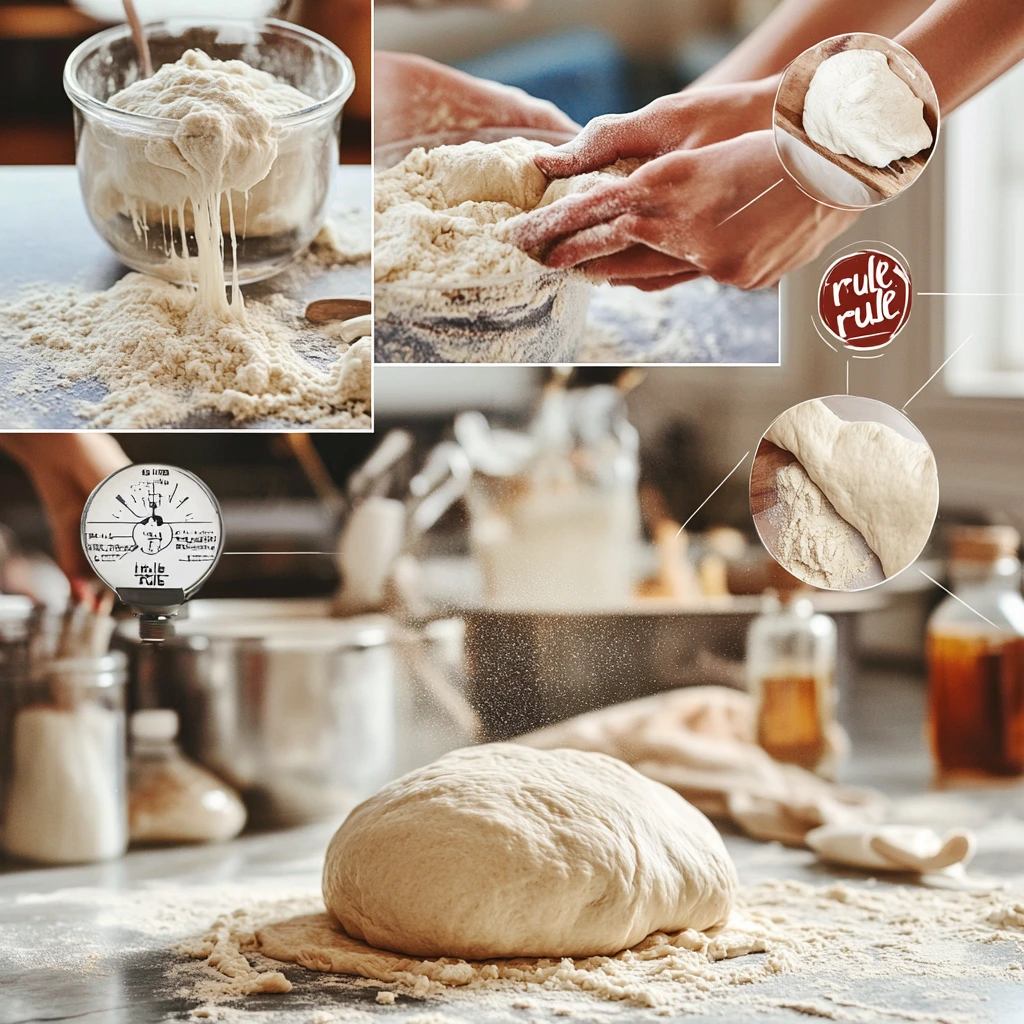Pizza is a beloved dish with countless variations, but no matter how you top it, the foundation of a perfect pizza starts with the dough. While many factors contribute to making the ideal pizza, one rule stands out for creating that perfect balance of crispy crust and tender bite: the 55 rule.
But what exactly is the 55 rule, and why does it matter? In simple terms, the 55 rule refers to the ideal ratio of hydration (water) to flour in pizza dough. By using 55% water for every 100% of flour, this rule helps achieve the right dough consistency, which is crucial for creating a dough that’s both flavorful and easy to work with.
Whether you’re a home baker or a seasoned pizza enthusiast, understanding the 55 rule can elevate your pizza game. In this guide, we’ll dive deep into what the 55 rule is, how it affects your dough, and why it’s so crucial for that mouthwatering, crispy crust you crave. Ready to unlock the secrets to perfect pizza? Let’s dive in!

Key Ingredients Involved in the 55 Rule
The 55 rule isn’t just about a simple ratio of water to flour; it’s a delicate balance of ingredients that work together to create the perfect pizza dough. Each component plays a crucial role in achieving the ideal texture, flavor, and rise. Let’s explore the key ingredients involved in this rule and how they contribute to your pizza-making success.
The Role of Pizza Flour
Flour is the backbone of any pizza dough, and the type of flour you choose can significantly impact your crust. Caputo flour, often used for Neapolitan-style pizza, is considered one of the best options because of its high protein content and fine texture, which helps develop gluten properly. When it comes to the 55 rule, selecting the right flour is essential because it directly affects how well the dough will absorb water and rise.
The protein content in flour—usually referred to as gluten—is what gives pizza dough its stretchiness and structure. Higher protein flours, such as bread flour, are ideal for making pizza because they form a strong gluten network, which is vital for achieving that desirable chewy texture in the crust. In contrast, all-purpose flour can also be used but will yield a softer dough, often with a more delicate bite.
The Impact of Water on Dough Consistency
Water is the other half of the 55 rule, and its role in pizza dough cannot be overstated. The 55% hydration level (55 grams of water per 100 grams of flour) ensures that the dough maintains the right level of moisture. This moisture is crucial for developing a dough that is easy to work with but not too sticky or dry.
When you mix water with flour, the proteins in the flour (glutenin and gliadin) begin to bond and form gluten. The right amount of water makes it easier for these proteins to create a stretchy, elastic dough that can hold its shape. Too much water can lead to a soggy dough, while too little water can result in a dry and crumbly texture. The 55% hydration level strikes the ideal balance, making it easier to stretch the dough and achieve that perfect pizza crust.
Additionally, water quality plays an important role in dough formation. Hard water, which contains high levels of calcium and magnesium, can strengthen the gluten network, while soft water can result in a more tender dough. Some pizza makers prefer to use filtered water to ensure consistent results.
Importance of Yeast and Salt in Fermentation
Yeast and salt are both essential for fermentation, which is the process that makes pizza dough rise and develop its characteristic flavor.
- Yeast: This single-celled organism is what makes the dough rise by consuming the sugars in the flour and producing carbon dioxide gas. This gas gets trapped in the dough’s gluten network, causing it to expand. Yeast is also responsible for the development of complex flavors as it ferments the dough over time. The longer the dough ferments, the more flavor it develops, which is why many pizza makers use a cold fermentation method for 24 to 48 hours to maximize the dough’s taste and texture.
- Salt: Salt does more than just add flavor; it helps control the fermentation process by slowing down the activity of the yeast, allowing the dough to rise more slowly. This slow rise helps develop a more complex flavor profile. Salt also strengthens the gluten structure, ensuring that the dough maintains its elasticity and doesn’t become too weak or sticky. Without salt, your dough could rise too quickly and lack the depth of flavor that makes a pizza truly delicious.
How the 55 Rule Affects Pizza Texture and Flavor
The 55 rule isn’t just a technical guideline for pizza dough—it’s a fundamental principle that influences both the texture and flavor of your pizza crust. By understanding how hydration and flour interact, you can create dough that’s not only easy to work with but also delivers that perfect balance of crispy, chewy, and flavorful characteristics. Let’s break down how the 55 rule impacts these key aspects of your pizza.

Gluten Development and Crust Thickness
One of the most noticeable effects of the 55 rule is the way it helps develop gluten, the protein network that gives pizza dough its structure and elasticity. Gluten formation is a critical step in pizza-making because it allows the dough to stretch without tearing, which is essential for creating a thin, even crust.
When you combine 55% water with 100% flour, the hydration level is just right for encouraging proper gluten development. Too little water can lead to a dense, tough dough that’s hard to stretch, while too much water results in a dough that’s sticky and weak. The 55 rule ensures that the dough maintains the perfect balance, allowing you to achieve a thin, crispy crust with a chewy interior.
The amount of water in the dough also influences the crust thickness. With the right hydration, the dough can expand evenly, resulting in a beautifully airy crust that isn’t too thick or too thin. This balance is key for a pizza that’s both crispy on the outside and soft on the inside, creating the signature texture many pizza enthusiasts crave.
The Ideal Baking Temperature
The 55 rule doesn’t only affect the dough’s preparation—it also influences how the dough reacts when it hits the heat. The right amount of hydration ensures that the dough will rise properly in the oven, creating a light, fluffy texture that’s not overly dense. This is particularly important when using high-heat ovens like wood-fired pizza ovens or pizza stones, which are designed to bake the pizza quickly while achieving a crisp crust.
At high temperatures, the dough’s moisture evaporates rapidly, causing it to puff up and create a light and airy texture. If the dough is too dry, it may not rise properly, leading to a crust that’s overly tough and flat. On the other hand, if there’s too much water, the dough could become soggy in the center. The 55 rule ensures the dough bakes evenly, resulting in a perfectly crispy, golden crust.
Balancing Flavor with the 55 Rule
While texture is important, flavor is where the 55 rule truly shines. The hydration level in the dough has a significant impact on its taste. With the ideal 55% water-to-flour ratio, the dough has enough moisture to ferment slowly, allowing the natural flavors of the flour and yeast to develop over time. This slow fermentation process, especially when combined with techniques like cold fermentation, allows for the creation of a dough that’s rich in flavor with a subtle tang.
The 55 rule also helps with dough fermentation by allowing the yeast to consume sugars in the flour and produce carbon dioxide gas. As the dough rises and ferments, it develops a deeper flavor profile. Without the proper hydration level, the yeast might either ferment too quickly or too slowly, resulting in a dough that lacks the rich, complex flavor that comes with longer fermentation periods.
Moreover, a well-hydrated dough allows for better flavor absorption from toppings like sauce, cheese, and herbs. The balance of moisture in the dough helps create a tender crust that complements the toppings without overwhelming them. This makes for a harmonious pizza experience, where each bite has a balance of flavor and texture that’s both satisfying and delicious.
The Science Behind the 55 Rule and Pizza Making
Understanding the science behind the 55 rule can help you appreciate why this hydration-to-flour ratio is so effective in making great pizza. It’s more than just following a simple recipe—it’s about the precise balance of water, flour, yeast, and salt, and how each element interacts at the molecular level to create the ideal pizza dough. Let’s break down the scientific principles that make the 55 rule work so well.

The Role of Cold Fermentation
Cold fermentation is one of the most important processes in pizza dough-making, and it’s closely tied to the 55 rule. The 55% hydration ratio allows for a long fermentation process, where the dough is allowed to rest in a cool environment (typically in the refrigerator) for 24-48 hours.
During this slow fermentation, the yeast breaks down the starches in the flour into simpler sugars. These sugars then get fermented by the yeast, producing carbon dioxide gas (which causes the dough to rise) and alcohol. This slow process not only contributes to a light, airy texture in the dough but also develops the flavor profile, creating a slightly tangy and complex taste that’s characteristic of high-quality pizza crusts.
Cold fermentation is ideal because it allows the dough to rise at a controlled rate. The yeast activity is slower at lower temperatures, which helps create a stronger gluten network without overwhelming the dough with rapid rises. The longer fermentation also allows for better flavor development as the sugars are gradually fermented over time, giving you that deep, rich pizza crust flavor.
The Autolyse Method and Its Connection to Hydration
The autolyse method is a technique often used in pizza dough-making that is highly compatible with the 55 rule. In this process, water and flour are mixed and allowed to rest before adding yeast and salt. During this resting period, the flour absorbs the water, which begins the process of gluten development. The autolyse method enhances the dough’s elasticity and extensibility, which are key for shaping and stretching the dough without it tearing.
In the context of the 55 rule, this method takes advantage of the perfect hydration level, where the water content (55%) allows the flour to fully absorb moisture, creating a dough that’s easy to work with. The result is a dough that stretches easily without snapping back, and the autolyse helps maintain the right dough consistency for pizza.
Water and Flour Interaction: The Hydration Equation
At the heart of the 55 rule lies the relationship between water and flour. When water is added to flour, the starches in the flour start to absorb the liquid and swell. As the flour hydrates, glutenin and gliadin, two proteins found in flour, begin to bond and form gluten. This gluten network gives the dough its structure and elasticity.
At 55% hydration, the dough achieves the ideal balance—it’s moist enough to form gluten effectively but not so wet that the dough becomes sticky or difficult to manage. The amount of water also influences the dough’s viscosity and how easily it can be shaped.
Water is essential for hydrating the yeast, which is why the hydration level must be just right for fermentation. If the water content is too low, the yeast won’t activate properly, and the dough will struggle to rise. Conversely, too much water can lead to an overly loose, sticky dough that doesn’t develop the right texture.
Why Pizza Dough Needs Time to Rest
One of the most critical aspects of pizza dough-making is resting time. As the dough rests, gluten continues to develop and strengthen, which helps improve the dough’s elasticity and stretchability. The resting period also allows the dough to relax, making it easier to shape and stretch without it shrinking back.
The 55 rule supports the resting process by maintaining an optimal hydration level, ensuring the dough remains workable even after several hours of resting. The water content keeps the dough moist, while the flour helps form the gluten network that strengthens over time. Resting also gives the yeast time to ferment the sugars, contributing to both the rise and flavor.
Tips for Applying the 55 Rule to Your Homemade Pizza
Applying the 55 rule to your homemade pizza dough may sound straightforward, but to truly master it, there are several essential tips and techniques that can elevate your pizza-making game. The beauty of the 55 rule lies in its balance of hydration and flour, which results in a dough that’s easy to work with, flavorful, and capable of producing a perfect crust. Here’s how you can apply the 55 rule to your homemade pizza with confidence.

1. Measure Your Ingredients Precisely
To get the most out of the 55 rule, precision in measuring is key. Use a digital kitchen scale for accuracy when measuring both your flour and water. This ensures that your hydration level is exactly 55%, which is crucial for achieving the right dough consistency. While traditional measuring cups can be convenient, they often lead to discrepancies, especially with flour, as it can be packed down or aerated, resulting in inaccurate measurements.
If you’re following a specific recipe, the general formula is 100 grams of flour to 55 grams of water, which means the water content is always 55% of the flour weight. Even slight variations can impact the texture of your dough, so invest in a scale for consistent results.
2. Choose the Right Type of Flour
Not all flour is created equal, and the type of flour you use will significantly impact the outcome of your dough. For the 55 rule to work as intended, choose high-protein flours, such as bread flour or 00 flour (a finely milled flour often used for Neapolitan-style pizza). These flours have a higher gluten content, which is essential for developing the structure and texture that make pizza dough stretchy and chewy.
If you opt for all-purpose flour, you may need to adjust the hydration level slightly, as it typically has a lower protein content. You might need to experiment a bit to find the exact hydration ratio that works for your flour type, but the 55% rule is a great starting point.
3. Water Temperature Matters
While the hydration level is crucial, the temperature of the water you use is just as important. Warm water (about 100°F or 37°C) helps activate the yeast more quickly, which can be useful if you’re aiming for a shorter fermentation time. However, if you’re planning on a long, cold fermentation, using cool or room temperature water is ideal. This slower rise allows for more flavor development and is perfect for that rich, tangy pizza crust that comes from fermentation.
In hot weather, use cool water to prevent the dough from fermenting too quickly, and in colder conditions, you might need slightly warmer water to ensure that the yeast activates at the right pace.
4. Don’t Skip the Resting Time
Resting time is essential for allowing the dough to relax and the gluten to develop. After mixing and kneading your dough with the 55% hydration ratio, cover it and let it rest at room temperature for at least 1-2 hours. This gives the dough time to rise and ferment, resulting in a lighter, airier texture.
For even better results, try cold fermenting your dough in the refrigerator for 24-48 hours. The slow fermentation enhances flavor and allows for the dough to achieve that slightly tangy, complex taste. Be sure to bring the dough back to room temperature before shaping it, as it’s easier to work with when it’s not too cold.
5. Use the Right Kneading Technique
Proper kneading is key when applying the 55 rule. The right amount of kneading allows you to develop the gluten network that gives the dough its structure and elasticity. Start by kneading the dough gently on a floured surface, being careful not to add too much flour, as this can affect the hydration balance.
A great method for kneading is the stretch and fold technique, where you gently stretch the dough and then fold it over onto itself, rotating it each time. This method is particularly effective for higher-hydration doughs, as it helps develop gluten without overworking the dough.
6. Experiment with Hydration Based on Your Climate
The 55% hydration level is ideal for most situations, but depending on your local climate and humidity, you may need to make minor adjustments. In dry climates, your flour may absorb water more quickly, so you may need to add a little extra water to keep the dough from becoming too stiff. In humid environments, you might find that your dough is more hydrated than expected, so reducing the water content slightly may yield better results.
Always feel free to adjust based on your experience and environmental factors. The 55 rule gives you a solid base to work from, but don’t be afraid to experiment with small changes to achieve the perfect dough for your pizza.
7. Roll and Shape with Care
When it comes to shaping your pizza, the 55 rule results in dough that’s soft, stretchy, and pliable, but still sturdy enough to hold your toppings. After the resting and fermentation process, gently press and stretch the dough by hand rather than using a rolling pin, which can deflate the air bubbles that contribute to the dough’s lightness and texture.
If you’re working with a high-hydration dough, like one made with the 55% hydration rule, it’s often best to shape the dough slowly and carefully, letting gravity help stretch it out. This ensures the dough keeps its airy structure and doesn’t become dense.
Chef’s Note
As any pizza chef will tell you, the perfect pizza dough is all about balance. The 55 rule serves as a fantastic guideline to achieve that delicate equilibrium between hydration and flour, resulting in dough that’s both manageable and delicious. Remember, while the 55% hydration rule is a great starting point, there’s always room for slight adjustments based on your ingredients, environment, and personal preferences. Don’t be afraid to experiment with different flour types, hydration levels, and fermentation times until you find the dough that feels just right for you.
Above all, pizza-making is an art that thrives on patience and practice. So, enjoy the process, and with each batch, you’ll get closer to mastering the science and soul of a truly perfect pizza. Happy baking, and may your crusts always rise to perfection! 🍕👨🍳
